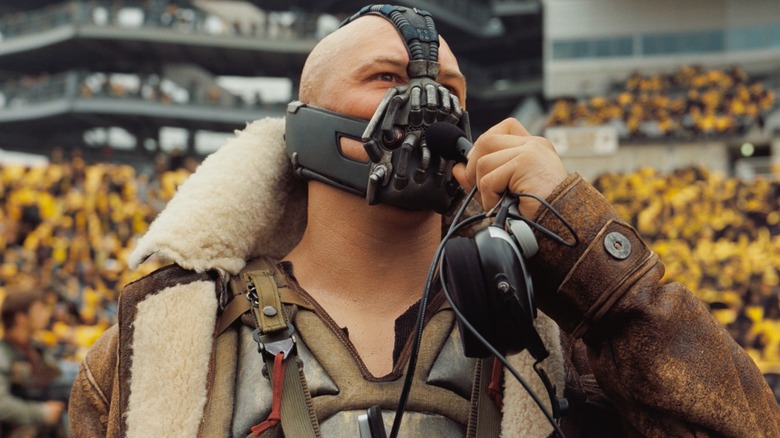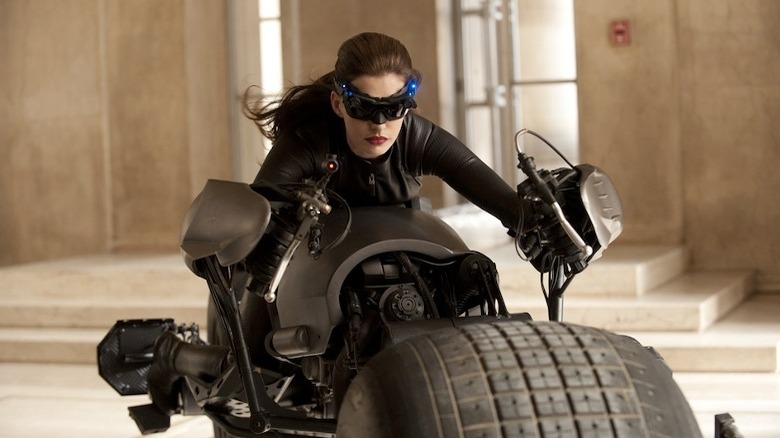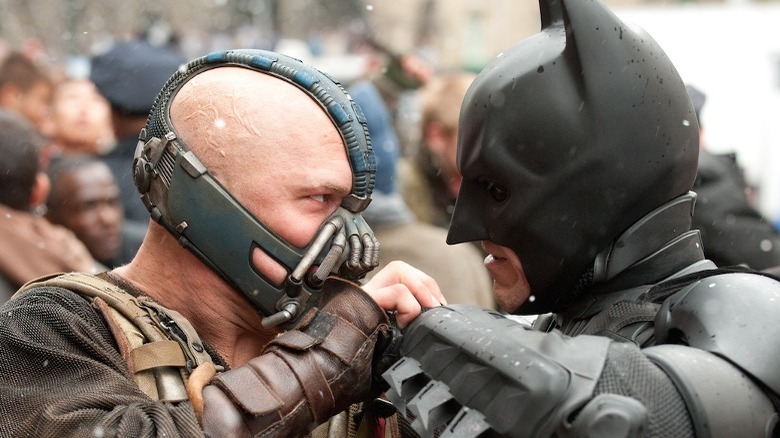Shooting In IMAX For The Dark Knight Rises Meant Going Practical For Its Most Extreme Scenes
Christopher Nolan is a modern filmmaker who approaches big-budget blockbusters with an eye for the traditional. From the rotating hallway fight scene in "Inception" to the destruction of a real Boeing 747 in "Tenet," the director has always favored practical effects over CGI for the most cinematically explosive set pieces. Nolan is also known for utilizing and revolutionizing the IMAX format, pushing the boundaries of what film cameras can capture. "The Dark Knight Rises," is particularly ambitious in its use of IMAX cameras, since Nolan wanted to shoot the entire movie in the format, meaning that its biggest scenes had to go even bigger.
IMAX theaters were projecting feature-length films since the early 2000s, starting with animation like "Fantasia 2000" before Digital Media Remastering (DMR) made it possible to bring live-action to a bigger screen. DMR raised film resolution when image sizes grew, preserving quality and crispness so that blockbusters like the "Harry Potter" films and and the original "Spider-Man" sequels didn't look blurry. However, none of these films were specifically shot with IMAX cameras, which were exclusively reserved for documentaries. Rather, DMR serves as a way to re-format footage shot on conventional film or digital cameras for a larger exhibition size. That all changed when Christopher Nolan shot scenes of "The Dark Knight" on 70mm IMAX film, including the car chase that ends with an actual, real-life truck flip. The incredible success of the film made Nolan a herald of the capabilities of IMAX that evolved even further when he returned to the technology when shooting "The Dark Knight Rises."
70mm mayhem
The sheer cost of IMAX film, as well as the cameras' noisy operating sound that tends to obstruct dialogue means that filmmakers are limited to shooting selective scenes in 70mm IMAX format (later films shot entirely on IMAX like "Avengers: Infinity War" and "Endgame" use digital Arri Alexa cameras). Whereas "The Dark Knight" had 28 minutes of IMAX footage, "The Dark Knight Rises" includes over an hour of it, clocking in at a whopping 72 minutes of 1.43:1 aspect ratio glory.
In order to get the full benefit of the cameras, the director once again relied heavily on stunts and practical effects. In one costly, death-defying moment that's a testament to the spectacle of the film, Anne Hathaway's stunt double crashed the Batpod into one of the cameras when riding down a flight of stairs. The immense, hands-on scale of the production is perhaps most evident in the scene shot at the Pittsburgh Steelers' Heinz Field (now Acrisure Stadium).
Bigger to biggest
For Bane's (Tom Hardy) intimidating terrorist attack on the Gotham Rogues' football arena, Nolan hired 11,000 extras to stand in view of the cameras and panic as the crew blew up mounds of dirt. The director said of the ambitious undertaking in an interview with Empire:
"I think this is the biggest one I've done ... The biggest one anyone's done since the silent era in truth, in technical terms. Shooting on IMAX, you wanna justify that we've put our resources more into what we were shooting on the day than computer graphics. It's not what you're used to seeing. I don't know when someone last did a film with 11,000 extras in a real environment. It is an escalation. You want things to be justifiably bigger and more extreme than what you've done in the last film. As long as the story supports that."
And he's not done innovating, either. Nolan's upcoming feature "Oppenheimer," about the creation of the atomic bomb, will feature an entirely new film type of film reel that will bring the format of black-and-white cinematography to IMAX. The film will also include a re-enactment of the first nuclear explosion — with no CG effects. Bold? Very much so. Surprising? Not the slightest bit for Chris.


